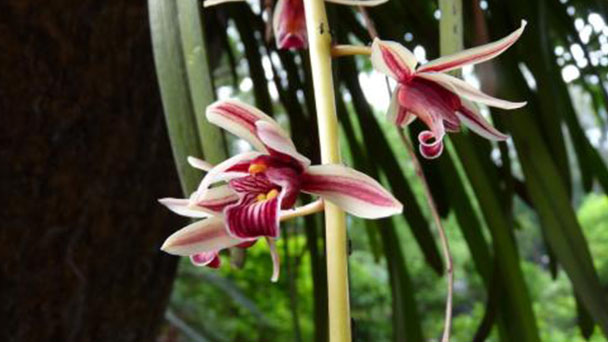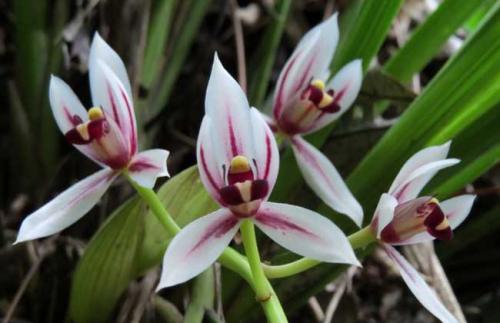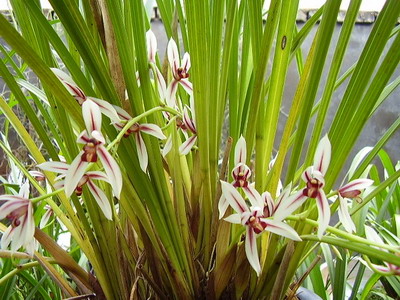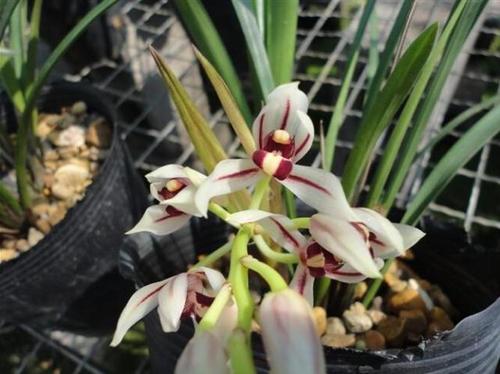Cymbidium dayanum profile
Written by Maggie
Aug 24 2021

Cymbidium dayanum is an epiphytic plant with pseudobulbs that are nearly fusiform and enclosed in the leaf base. Cymbidium dayanum has 4-9 leaves, hard papery, dark green, scapes emerging from the base of pseudobulbs, 18 -- 35 cm long, racemes with 5-9 flowers, sepals and petals white or creamy yellow, sepals narrowly oblong-elliptic, petals narrowly ovate-oblong, flowering from summer -- winger.
Cymbidium dayanum is found on trees in open forests or on the rocky sides of valleys, at altitudes of 300 to 1,600 meters. It is cultivated in southern Fujian, Taiwan, Guangdong, Hainan, Guangxi, southwestern and southern to southeastern Yunnan, and also distributed in Sikkim, India, Myanmar, Vietnam, Laos, Cambodia, Thailand, Malaysia, Indonesia, the Philippines and Japan.
Cymbidium dayanum has a long flowering period and is of high ornamental value.
Cymbidium dayanum picture

Morphological characteristics of Cymbidium dayanum
Leaf
Cymbidium dayanum is an epiphyte; Pseudobulbs are subfusiform, slightly compressed, 2 -- 5 cm long, 1.5 -- 2.5 cm wide, enclosed in leaf base. Cymbidium dayanum has 4-9 leaves, banded, 32 -- 60 (110) cm long and 7 -- 13 mm wide, hard papery, dark green, apex acuminate, unlobed, midvein and lateral vein raised abaxially (usually lateral vein more prominent than midvein, especially lower), articular 7 -- 12 cm from the base.
Scapes
Scape of Cymbidium dayanum sheaths from the base of pseudobulb, 18 -- 35 cm long, descending or pendulous; Racemes with 5-9 flowers; Bracts are subtriangular, 4-5 mm long; Pedicels and ovaries are 1 -- 2 cm long, prolongation later; Flowers are 4-5 cm in diameter, usually fragrance-free; Sepals and petals of cymbidium dayanum are white or creamy yellow, 1 maroon longitudinal band in the center extending from the base to upper 3/4 or occasionally full of pale red, labellum white only in the center of the base and middle lobe, basal remainder maroon, lateral lobes densely maroon veined, folds white or creamy yellow; Sepals are narrowly oblong-elliptic, 2.2 -- 2.7 cm long, 5 -- 7 mm wide;
Petals
Petals of Cymbidium dayanum are narrowly ovate-oblong, 1.7 -- 2.3 cm long and 4 -- 6 mm wide; Lower sepal is subovate, 1.5-1.9 cm long, 3-lobed; Lateral lobes are subequal to stamen column; Middle lobe is abscurved; On the labial disc there are 2 longitudinal folds extending from the base to the base of the middle lobe, with dense glandular hairs on the upper part, and 2 glandular hairs on the front end of the fold extending to the middle of the middle lobe. Stamens of Cymbidium dayanum are 9 -- 10 mm long, slightly curved forward, ca. 1/2 -- 3/5 of sepal length; Flowery powder balls 2, nearly triangular.
The fruit
The capsules of Cymbidium dayanum are elliptic, 4 -- 5 cm long and 2 -- 2.8 cm wide.
Ecological habits of Cymbidium dayanum
Cymbidium dayanum generally grows on the mountainside and valley walls of deep mountains and valleys, on sloping slopes or stone crevices with good water permeability and water retention, near sparse mountain grasses and under the shade of secondary miscellaneous trees. Or have shade, the sunshine time is short or only the place where the star leaks light. Where the air is moist and can circulate, it is sometimes born on the side of mountain streams and cliffs.
Cymbidium dayanum is best grown in a well-ventilated environment. Cymbidium dayanum likes shade, avoid direct sunlight, like wet, avoid dry, 15℃ to 30℃ most suitable for growth. Poor growth above 35℃.Cold temperature below 5℃ will affect its growth when the orchid is often in a dormant state. If the temperature is too high and the sun is exposed to the sun, the leaves will burn or scorch within a day or two. If the temperature is too low and did not transfer into the house in time, there will be a frostbite phenomenon.
Cymbidium dayanum has fleshy root. It is suitable for sandy loam with rich humus. It must have good drainage performance, and leaf rot or mountain soil with more humus should be selected. Slightly acidic loose soil or soil containing iron, pH value of 5.5-6.5 is appropriate.
How to grow and care for Cymbidium dayanum
Light
Cymbidium dayanum requires about 30000 - 40000 lux. The degree of mild must be as excessive as possible, averting solely the direct southern solar that can burn the leaves, in particular when the mild degree rises sharply. Strong air motion ought to be ensured all the time.
Temperature
The common temperature of the summertime day is 23-25 ° C, the nighttime 16-17 ° C, and each day distinction is 6-9 ° C. The common temperature of the spring day is 27-28 ° C, the night time 10-16 ° C, and the day-by-day distinction drops from 18 to eleven ° C. Cymbidium dayanum can tolerate brief frosts however it is no longer recommended. Cymbidium dayanum thrive very nicely in environments the place there is a remarkable distinction in temperature between day and night.
Humidity
In the summer season and early autumn, the humidity is 80-85%, and at the give-up of iciness and early spring, it drops slowly to 60-65%. Increase environmental humidity with humidifiers, for example, or via spraying daily, however, be cautious no longer to moist the flowers.
Watering
Cultivated Cymbidium dayanum must be abundantly watered each 2-3 days from the quit of spring and in the summertime months till autumn, however terrific drainage ought to be ensured, and the base around the roots can by no means be soggy or stale. In autumn, the quantity of water has to be limited. During the wintry weather months, water as soon as a week and by no means when it rains or is about to rain.
Fertilizer
It is encouraged to follow half of - 3/4 doses of fertilizer for orchids each and every week in the developing season. Many breeders opt for the use of sustainable fertilizer at some stage in the year; others use high-nitrogen fertilizer from spring to mid-summer, and then high-phosphoric fertilizer till the quit of autumn.
Repotting
Every 2, three, or four years and need to be carried out when new roots begin to develop at the top of winter, as lengthy as the flora do now not have flowering shoots or right away after flowering.

The propagation of Cymbidium dayanum
Division
In spring and autumn can be carried out, generally every three years a plant. Any plant with strong growth and dense pseudocorms can be divided, and at least 5 connected pseudocorms should be stored in each cluster after division. Before planting, reduce irrigation water, so that the basin soil is more than. After planting, cover the bottom hole of the pot with broken tiles, then lay coarse stones, which account for 1/5 to 1/4 of the depth of the pot, then put coarse-grained soil and a small amount of fine soil, and then plant with sandy loam rich in humus. Planting depth to the false corm just buried in the soil strength, basin edge to leave 2 cm along with the mouth, spread Cui Yun grass or fine stones, finally pouring permeable, shady place for 10-15 days, keep the soil moist, gradually reduce watering, normal maintenance.
Seed propagation
The seed of Cymbidium dayanum is very thin, and there is only one incomplete embryo in the seed, so its germinating ability is very low. Besides, the seed coat is not easy to absorb water, so it cannot germinate by conventional sowing methods. Therefore, Cymbidium dayanum fungus or artificial medium is needed to supply nutrients for germination. Planting fruit had better choose not cracking, surface with 75% alcohol after sterilization, remove the seeds, soaking with 10% sodium hypochlorite for 5-10 minutes, take out three times with sterile water rinse again can play in the cultivation of the bottle containing medium, and dark in the pure, keep temperature 25 ℃ or so, stirring and then moved to the light that can form the original bulb. From sowing to transplanting, it takes half a year to a year. Tissue culture has been successful and can be propagated by this method where conditions permit.
Prevention and control of diseases and pests
Disease control
Southern blight
Mostly in the rainy season. At the beginning of the disease, the leaf base is full of white mycelium. Cause root rot. Prevention and control method: remove fungus basin soil, sprinkle on pentachloronitrobenzene powder or lime. Radical cure method: pay attention to ventilation and light, basin soil drainage is good. Serious diseased plants are burned.
Anthrax
It occurs all the year-round, and is more prevalent in hot and rainy seasons, especially in Cymbidium dayanum. The spots first extend from the tip of the leaf to the rhizome, brown at the beginning, and then gradually expand and increase, there are many dry black spots, which lead to the death of the whole plant in serious cases. Prevention and control methods: in addition to actively change the environmental conditions, in the onset period, can be used first with 50% methyl tobujin wettable powder 800-1500 times the liquid spray treatment, once every 7-10 days; Then supplemented with 1% equivalent Bordeaux liquid, once every half a month, continuous spray 3-5 times.
Pest control
Scale insects
Commonly known as "lice". They propagate fastest in conditions of high temperature, humidity and poor airflow. It can be sprayed with 1% diethoate oxide or 1500 times 50% mala sulfur during incubation period. If the number of pots is not much, it can also be brushed manually.
The region of Cymbidium dayanum
Cymbidium dayanum is cultivated in southern Fujian, Taiwan, Guangdong, Hainan, Guangxi, southwestern and southern to southeastern Yunnan, and also in Sikkim, India, Myanmar, Vietnam, Laos, Cambodia, Thailand, Malaysia, Indonesia, the Philippines, and Japan.
The use of Cymbidium dayanum
Cymbidium Dayanum is a variety of Cymbidium. Cymbidium dayanum has both the delicate fragrance and elegance of national orchid and the wealth and honor of foreign orchid. Cymbidium dayanum has a long flowering period, and has high ornamental value, but also has the value of edible, medicinal and food additives, and has a great development prospect.

Latest Updated
- Benefits of Bugleweed - 7 Science-backed Health Benefits
- Bugleweed Dangers & Side Effects - Is It Poisonous?
- How to Plant Evergreen Trees - What You Should Know
- When to Plant Evergreens - Grow Guide for Evergreen Trees
- 12 Wonderful Evergreen Shrubs for Your Garden
- 12 Popular Evergreen Plants with Pictures for Beginners
- When And How To Prune A Lilac Bush Like a Pro
- How to Grow & Care for Lilac Vine (Hardenbergia Violacea)
- Japanese Lilac Tree (Syringa Reticulata) Care & Propagation Guide
- Shumard Oak Pros and Cons - What to Know
Popular Articles
- Winter maintenance of Antirrhinum Majus
- How to Grow Terminalia Mantaly Tree
- How to Grow and Care for Crossostephium Chinense
- How to grow Antirrhinum Majus in spring
- Peristeria Elata (Dove Orchid) Profile: Info & Care Guide
- Underwatered Snake Plant (Sansevieria Trifasciata) - Signs And How To Fix
- How to Care for Brazilian Jasmine Plant (Mandevilla Sanderi)
- How to Grow & Care for Graptopetalum Purple Delight in Summer
- Rosa Chinensis (China Rose): Plant Growing & Care Tips
- How to Care for Baby Sun Rose (Aptenia Cordifolia)